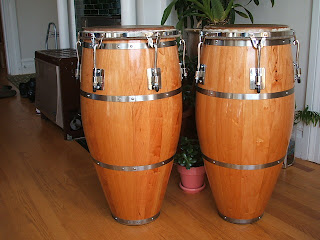
Contemplating a purchase of an artisan-crafted set of congas can be exciting and fun. It can also be daunting and confusing. The first step is deciding whether or not you should buy a set of congas like this. Artisan crafted congas come with several advantages but there are also drawbacks.
Congas of this type can be hard to try before you order them. So, many, are left to reviews, research and opinions. This kind of information can be very subjective. Everyone that just spent $800 for a conga wants to believe it is the best money can buy. So the first risk is potentially not knowing exactly what you’re going to get for your money. Drum makers will also change their designs, so their end product may be different than what is seen in pictures.

Another thing about handcrafted drums is they come with a waiting period. Are you the type of person that has the patience for that? 6 month or even 9 month waiting periods are not uncommon. Also not uncommon are unseen delays; skins become unavailable, shells can develop defects in the manufacturing, etc. I’ve known people to wait over a year for drums.
A related issue is parts and repairs. If something should happen to your drum and you need a repair or a new part, you would be required to ship the drum back or wait for a new part to be manufactured. Granted drum makers are usually very conscientious in this regard, but shipping costs are ofen involved and waiting. Compare this to either getting a brand new drum on the spot, or simply walking into a shop and having the part you need hanging on the wall, which is possible with other types of drums.
The main reason why people choose handcrafted drums is for the sound. In my opinion they do sound better. They all sound good. They almost all sound very good. I’ve heard a lot of these types of drums and I can’t really say that one artisan's drums are better sounding than the a different artisan's. Maybe I could describe subtle difference, but a good sounding drum is a good sounding drum. In fact, my experience with these types of drums, is that they sound more similar than disimilar when compared to each other, even drums of different woods and makers. However, the person you’re playing with may have a crappy sounding drum, or are you going to have your drums played as a set most of the time? Then you have 3 good sounding drums playing together. So the context of where you are playing most should also be considered.
The way I have chosen all my drums from the many choices is that there was something that resonated with me about the drum maker. Sometimes it is their history, sometimes it is their particular approach to design and fabrication, it could be personality, reputation; many reasons. I am of the opinion that there should be something you like about the drum maker and this will transfer to your ownership of the drums. I’ve played and heard a lot of these kinds of drums, and I can’t say that one sounds better than the other, and you can drive yourself crazy thinking along those lines. These guys usually just don’t let poorly sounding drums out of their shop. However, as you research the different manufacturers surely something about how the drums look, the way they are built, the history of the company will stand out. That is how I’ve chosen my drums and I’ve never regretted it.

Always remember that there are other choices out there, cheaper and more readily available choices that don’t rely on faith. Keep these other choices in mind, but if they just don’t seem to grab your attention, if they lack the appeal, or just don’t seem to satisfy; if you are willing to endure the wait and the cost; if you want a handcrafted conga with a history, a status, and reputation; something not everybody else has; if you need that level of sound; then you should probably get yourself this kind of drum.


























